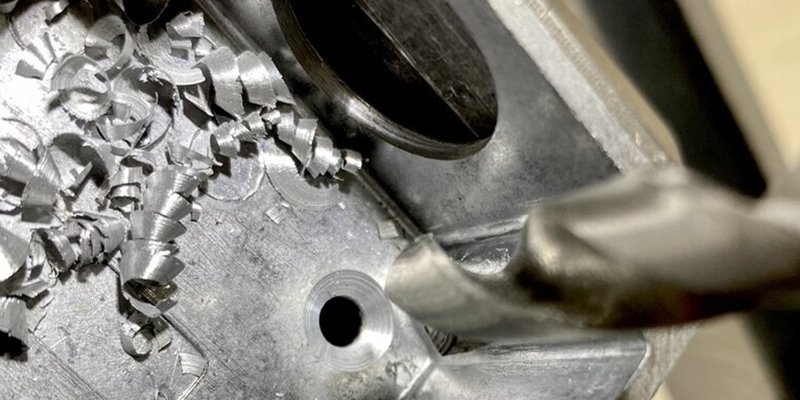- June 9, 2023
Protruding screw heads are unsightly and often tamper with the aesthetics of metal parts. Countersinking is a process that helps prevent this protrusion and involves the enlargement of the pilot hole’s rim.
Therefore, the primary purpose of countersinking is to hide the screw head in metal, wood, or plastic parts. It also helps prevent severe injuries or scratches which could occur as a result of protruding screw heads.
In this article, we will provide you with information on how to make a countersink hole in metal. We would also highlight the types of drill bits used for making countersinks in metals and the common applications of these holes. So, read on.
Step by Step on How to Make A Countersink Hole in Metal
Countersinking metals is not difficult, especially with the knowledge of the types of holes and the right tools for the job. Below is a step-by-step breakdown of how to make a countersink hole in metal.
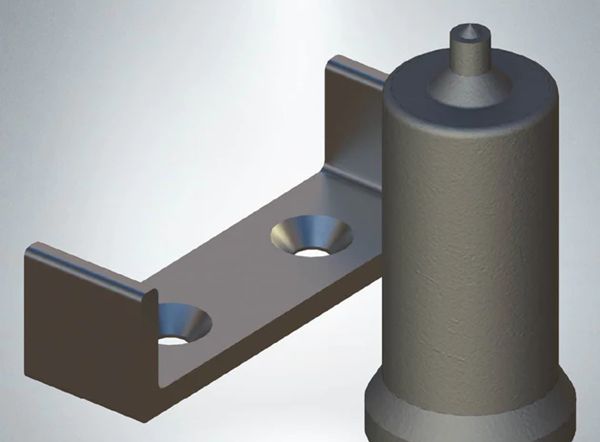
1. Drill the Pilot Hole
Before making a countersink hole, you need to drill the pilot hole. The first step when drilling a pilot hole is choosing the diameter of the screw shaft you want to use, as it would help select the right drill bit. Ensure the drill bit selected is the same size as the screw or 1.6mm smaller.
Before starting to drill a hole, securing the metal using a clamp is best to ensure no movement occurs during drilling. After ensuring the metal is secure, mark where you want to drill, then install a drill bit.
When drilling, hold the drill in a way that it is perpendicular to the metal surface and press down its trigger. Apply pressure to the drill until it reaches the same size as the screw you intend on using with the hole.
2. Check and Ensure the Countersink Angle is Correct
Using the wrong countersink angle defeats the purpose of countersinking, as the metal part would still appear unsightly. So to ensure secure screw fitting, you must have the correct countersink angle. For instance, when countersinking metric screws, the recommendation is a 90-degree angle, while standard screws have a recommended 82-degree countersink.
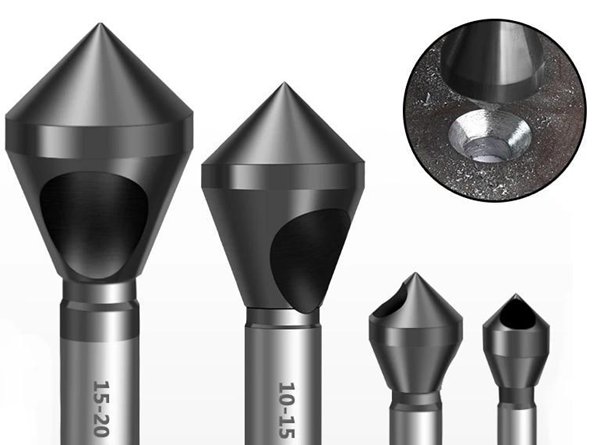
3. Select the Correct Countersink Drill Bit
Choosing the right countersink drill bit involves selecting the right drill bit diameter. The reason is that the diameter of the drill bit plays a major role in determining how snugly the screw would fit into the countersink hole after drilling.
If you use a drill bit diameter that is less than that of the screw, then the protrusion of the screw head is inevitable. Thus, it is best to use drill bits approximately the same size as the head of the bolt or screw you want to use.
To measure the screw or bolt head, it is advisable to use a caliper and tighten its jaws around the screw head. The aim here is to ensure that the screw head does not protrude. Instead, it fits flush within the countersink hole.
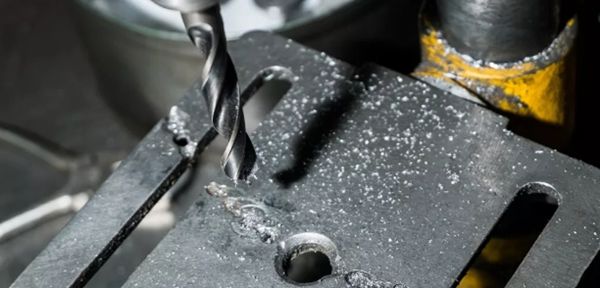
4. Insert The Countersink Drill Bit Into The Drill Chuck
The drill chuck is the part of the drill that holds the bit in place. It is especially important when the drill bit is spinning to avoid accidents. This component has a tightening collar as well as a three-way vice. The best way to tighten the drill bit into the chuck mostly depends on the drill design. However, the common ways are using a chuck key or chuck wrench by hand.
For designs that require a chuck key, you would find an open hole on the chuck for key insertion and subsequent tightening or loosening.
Additionally, tightening the chuck is fine, but ensure it is not too tight so as not to experience difficulty detaching the countersink drill bit after drilling.
5. Adjust the Drill to the Right Depth
When you make a countersink hole in metal, the depth and bit type is important if you want the screw head to sit flush with the metal. It is best to set the adjuster to 4mm or more to get the correct depth.
Also, note that the precise depth you would set the adjuster to depends on the size of the screw-bolt head. Using the correct depth would help prevent excessive countersinking (The presence of a gap on top of the screw head) or screw head protrusion from the metal part.
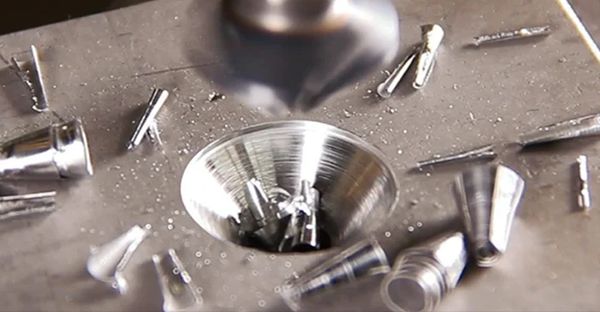
6. Drill the Countersink Hole
Push the drill with the countersink bit attached lightly to the pilot hole to drill the countersink. Drill down until you achieve the desired depth. It is important to note that the exact depth of drilling depends on the size of the screw head and the countersink bit.
7. Inspect the Countersink Hole
On the completion of drilling, check the countersink hole using a bolt or screw. Ensure the bolt or screw sits flush with the metal surface.
Different Materials of Countersink Drill Bit for Metal
There are different material bits for countersinking work, and the type chosen often depends on the workpiece. They include:
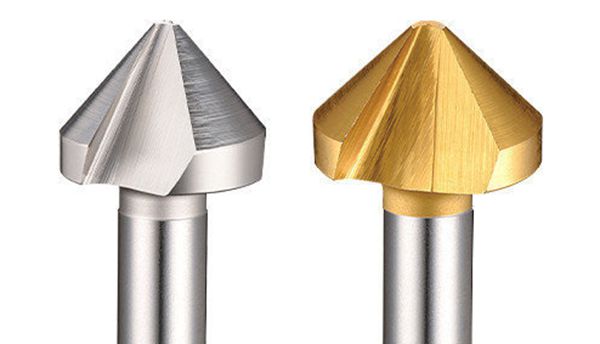
High-Speed Steel (HSS)
These are drill bits made from High-speed steel. This steel contains chromium, vanadium, cobalt, carbon steel, and tungsten or molybdenum. HSS finds use in countersinking for metals due to their ability to withstand high temperatures (up to 6500C) without losing their hardness.
Besides, drill bits are made from HSS drill metals at speeds 3 times the rate of conventional drill bits.
Carbide
Carbide drill bits or tungsten carbide drill bits are made from a combination of carbon and tungsten. They have superior strength, which gives them use when engineers make a countersink hole in metal.
Drill bits in this category can also operate at high speed due to their ability to absorb heat efficiently. Carbide drill bits can be cut through copper, bronze, steel, aluminum, cast iron, and other abrasive metals.
Cobalt
These drill bits contain high-speed steel alloy with 5 to 8% cobalt. The cobalt content of this drill bit makes it more heat resistant, an important attribute for metal drilling. This heat resistance makes heat damage less likely when using cobalt drill bits.
Besides, cobalt drill bits are ideal for countersinking on hard metals like cast iron and stainless steel.
Standard Countersink Angle in Different Uses
There are several countersink angles, and they all have different uses. However, below are the most common countersink angles and their uses.
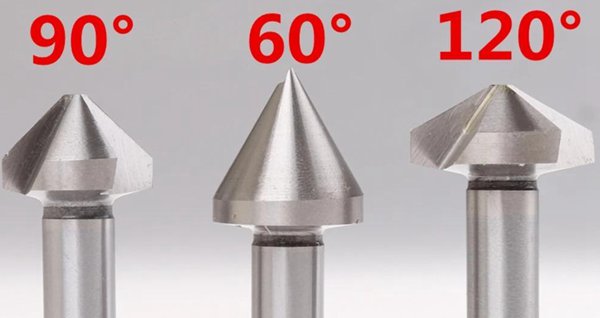
60° (Deburring)
The primary purpose of this countersink angle is to remove burrs or sharp edges from the screw area of a metal part. After deburring, the metal has smoother edges.
75° (Rivet Heads)
The rivet head angle is ideal for most rivet head types, including drive, flush, friction-lock, Oscar, self-piercing, structural steel, and solid rivets.
82° and 90° (Countersunk Screw)
There are two angles for countersunk screws. However, the exact angle chosen is a function of the industry countersink screw standard. For instance, the US standard is 82°, while other countries and regions use 90° countersunk screws and the same angles.
120° (Countersinking Sheet Metal Rivets)
The type of rivets used for sheet metals are the thinner and blind Rivets, often requiring a countersinking angle of 120°. This angle requirement is due to their use in joining sheet metals.
Size Charts for Typical Countersink Dimensions
Below are charts showing the typical countersink dimensions for angles 82°, 90°, and 100°.
Dimension Chart for 82° countersink angle in Inches
| Fastener Size (Thread) | Pilot Hole Diameter (Close Fit) | Pilot Hole Diameter (Normal Fit) | Pilot Hole Diameter (Loose Fit) | Countersink Diameter |
| #0 | 1/15 | 6/79 | 3/32 | 5/42 |
| #1 | 3/37 | 4/45 | 4/45 | 13/89 |
| #2 | 3/32 | 7/69 | 7/62 | 16/93 |
| #3 | 5/47 | 8/69 | 9/70 | 1/5 |
| #4 | 3/25 | 9/70 | 14/97 | 9/40 |
| #5 | 9/64 | 5/32 | 11/64 | 25/99 |
| #6 | 2/13 | 10/59 | 5/27 | 12/43 |
| #8 | 9/50 | 10/51 | 13/61 | 1/3 |
| #10 | 15/73 | 21/95 | 5/21 | 5/13 |
| #12 | 15/64 | 15/61 | 6/23 | 39/89 |
| 1/4 | 17/64 | 9/32 | 19/64 | 36/71 |
| 5/16 | 21/64 | 11/32 | 23/64 | 40/63 |
| 3/8 | 25/64 | 13/32 | 27/64 | 16/21 |
| 7/16 | 29/64 | 15/32 | 31/64 | 69/85 |
| 1/2 | 17/32 | 9/16 | 39/64 | 7/8 |
| 9/16 | 19/32 | 5/8 | 43/64 | 1 |
| 5/8 | 21/32 | 11/16 | 47/64 | 1 1/8 |
| 3/4 | 25/32 | 13/16 | 29/32 | 1 3/8 |
Dimension Chart for 90° Countersink Angle in Millimeters
| Fastener Size (Thread) | Pilot Hole Diameter (Close Fit H12) | Pilot Hole Diameter (Normal Fit H13) | Pilot Hole Diameter (Loose Fit H14) | Countersink Diameter |
| M3 | 3.2 | 3.4 | 3.6 | 6.94 |
| M3.5 | 3.7 | 3.9 | 4.2 | 8.96 |
| M4 | 4.3 | 4.5 | 4.8 | 9.18 |
| M5 | 5.3 | 5.5 | 5.8 | 11.47 |
| M6 | 6.4 | 6.6 | 7 | 13.71 |
| M8 | 8.4 | 9 | 10 | 18.25 |
| M10 | 10.5 | 11 | 12 | 22.73 |
| M12 | 13 | 13.5 | 14.5 | 27.21 |
| M16 | 17 | 17.5 | 18.5 | 33.99 |
| M20 | 21 | 22 | 24 | 40.71 |
Dimension Chart for 100° Countersink Angle in Inches
| Fastener Size (Thread) | Pilot Hole Diameter (Close Fit) | Pilot Hole Diameter (Normal Fit) | Pilot Hole Diameter (Loose Fit) | Countersink Diameter |
| #0 | / | 6/79 | 3/32 | 5/42 |
| #1 | 3/37 | 4/45 | 8/77 | 13/89 |
| #2 | 3/32 | 7/69 | 7/62 | 16/93 |
| #3 | 5/47 | 8/69 | 9/70 | 1/5 |
| #4 | 3/25 | 9/70 | 14/97 | 9/40 |
| #6 | 2/13 | 10/59 | 5/27 | 12/43 |
| #8 | 9/50 | 10/51 | 13/61 | 1/3 |
| #10 | 15/73 | 21/95 | 5/21 | 5/13 |
| 1/4 | 17/64 | 9/32 | 19/64 | 36/71 |
| 5/16 | 21/64 | 11/32 | 23/64 | 40/63 |
| 3/8 | 25/64 | 13/32 | 27/64 | 16/21 |
| 7/16 | 29/64 | 15/32 | 31/64 | 81/91 |
| 1/2 | 17/32 | 9/16 | 39/64 | 1 1/59 |
| 9/16 | 19/32 | 5/8 | 43/64 | 1 10/69 |
| 5/8 | 21/32 | 11/16 | 47/64 | 1 25/92 |
Conclusion
Making a countersink hole in metal is a process that requires high precision as it involves part aesthetics. While it is relatively straightforward, it requires a level of technicality so as to avoid damaging metal parts during the process.
In this article, we discussed countersinking holes and how to make a countersink hole in metal. Are you looking for a reliable company to create countersink holes on your CNC metal parts? Contact WayKen today.
FAQ
What are the main differences between countersink holes vs counterbore holes?
The main difference between countersink holes and counterbore holes is the angle of the hole bored. A counterbore hole is cylindrical with a flat bottom, while a countersink hole has a conical shape.
What is the minimum metal thickness to countersink?
Countersinks typically have a minimum sheet thickness of 0.032″ and a maximum depth of two-thirds the thickness of the sheet.

